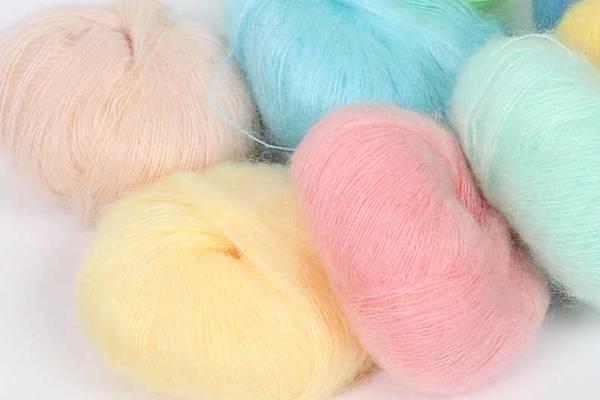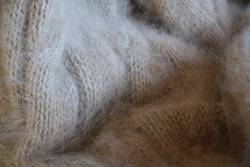
What Is Angora Fabric And Where Does Angora Come From?
This is a nice wool considered to be one of the finest versions of that fabric you can buy. The material makes for great clothing as well as lining as the fibers are hollow and retain heat very well. Plus, it is hypoallergenic making it perfect for allergy sufferers.
What is angora fabric? The surprising source for this material is the angora rabbit. This fabric is one of the many wool varieties that is said to be one of the finest materials you can buy. If you have allergies to hair, this is the wool you should buy.
To learn more about angora fabric, just continue to read our article. It has the up-to-date information you need in order to plan your next angora wool sewing project. Take a few moments to learn about this top-quality material that feels silky and soft.
What is Angora Fabric?

This material is a very fine wool that measures between 12 to 16 microns. Because of this fine measurement, the fibers when woven into a nice cloth are very soft and nice to touch.
Along with the silky softness texture, the material is nice and fluffy and with its hollow design, the material has great heat retention. The hypoallergenic nature of the material makes it a perfect fabric for those people who suffer from asthma and allergies.
Like any natural fiber, some people oppose its harvest due to what they claim is unethical treatment of the rabbits. It will be up to you to decide if you are going to oppose those protesters and make nice garments out of this material.
If you do, you will have a very nice sweater, blouse, or lining for whatever sewing project you want to use this fabric on.
What is Angora Fabric Made of?

There is no delicate way to put this. The angora fabric comes from natural fibers which are found on Angora rabbits. It is a 100% natural material that has positive qualities when made into clothing items.
Basically, you could call it, and it is often called, rabbit fur. That is the source of the angora fabric. There are no synthetic alternatives to this material that we could find. The good news is that the rabbits are not killed for their fur.
Most often, the rabbits are sheared like sheep or other wool-producing animals so the rabbit gets to live another day to produce more fur for angora fabric. Sometimes, the animals have to be plucked if the rabbit is not naturally shedding their fur.
Also, no chemicals are used in the process of turning this fur fiber into yarn or fabric. It is washed before spinning.
Where Does Angora Come From?

The original country that seems to have first cultivated and used the fur of the angora rabbit is Turkey. The city of Ankara which was known in Europe as Angora was the accepted point of origin for these rabbits.
There is no known origin date for when these rabbits were bred or when their fur was first turned into fabric or yarn. But, by the 18th century, all of Europe had the opportunity to make use of this material.
There are several different types of angora rabbits and one of the fluffiest or hairiest of all the types is the English angora. Then there is the French angora which does not produce fur on its face and it produces less wool than other angora varieties.
Giant angora rabbits get as large as house cats and produce a large amount of fur, while the satin angoras produce the least. The latter rabbits also have the thinnest fibers as well as the softest.
Angora Material Uses

There are lots of uses or applications for angora material. The first would be different craft projects that work well for knitting. Then most of the applications or uses pertain to clothing items or their accessories.
Scarves, gloves, and other fashion and winter accessories are just a few of the uses this material has. Then the fabric is often made into pea coats for warmth or suit jackets for class and style.
It is possible, although it is a rare event, to turn this fabric into a nice throw blanket or pillowcases. It makes for a nice soft bedding material that would be good for allergy sufferers who may have some reactions to other wool bedding made from sheep, etc.
You can be creative and innovative to see if you can come up with some more uses or applications but nothing is guaranteed.
Finding Angora Fabric by the Yard

This may be easy as tons of this fabric are produced every year. The three main producers are China, Turkey, and the US. Unfortunately, even though thousands of tons are produced every year, the cost of this fabric ranges from $20 per ounce and up.
There are a lot of stores that sell this material and Mood Fabrics has it starting at $40 and going up to $80 with one version at $18. Another smaller outlet has the material at just over $40 and that is the sale price and you have to pay for shipping.
You may have some difficulty finding the fabric as some stores avoid the Chinese version of this material. They avoid it due to the cruel ways the Chinese firms harvest the fur. It will be up to you if you decide to use Chinese angora fabrics.
It may not be someone’s first thought to have wool come from rabbits but these animals produce a lot of fur which they shed naturally. The surprising aspect is that this fur is one of the finest versions of wool you can buy.
Its soft, silky texture makes sure you feel good as well as warm when you use this fabric for clothing or fashion accessories.

